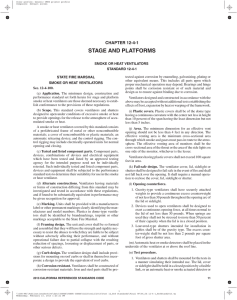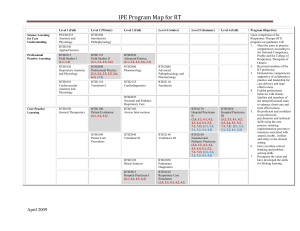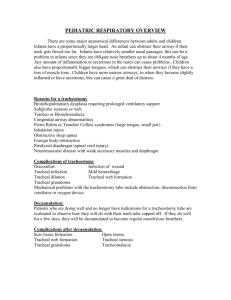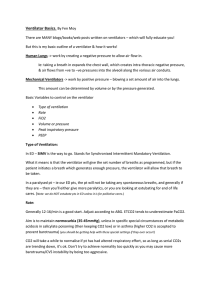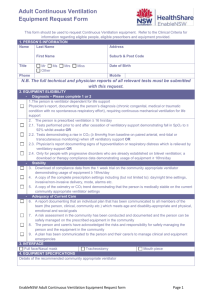Guidelines for Acquisition of Ventilators to Meet Demands
advertisement
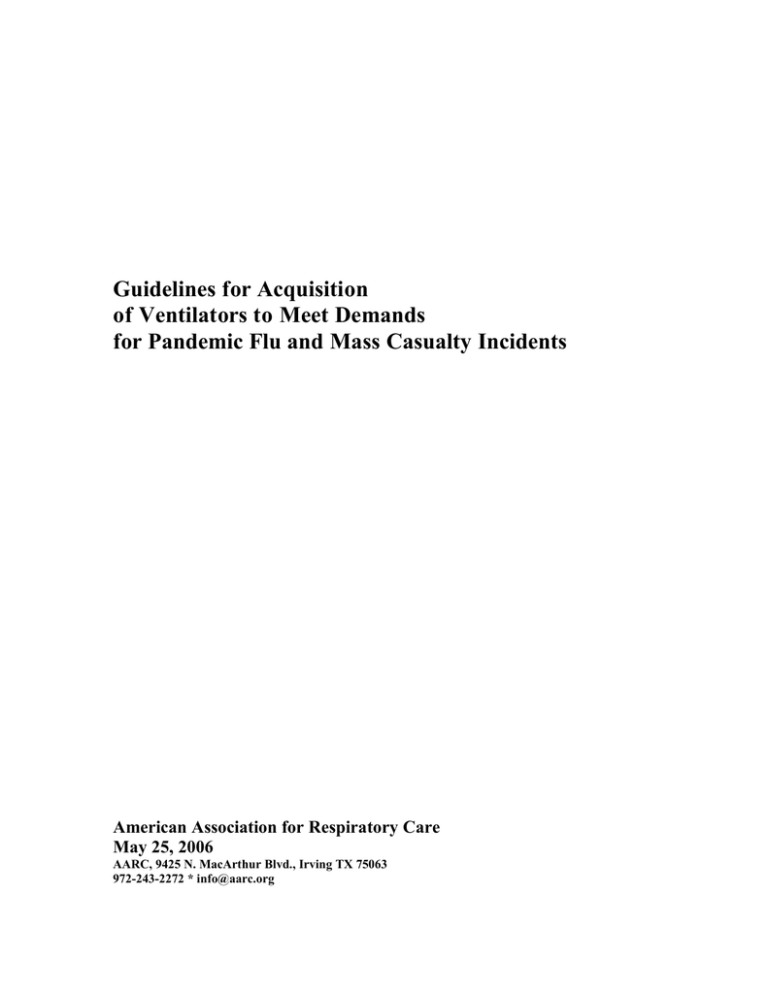
Guidelines for Acquisition of Ventilators to Meet Demands for Pandemic Flu and Mass Casualty Incidents American Association for Respiratory Care May 25, 2006 AARC, 9425 N. MacArthur Blvd., Irving TX 75063 972-243-2272 * info@aarc.org Introduction Following the tragedy of September 11, 2001 and the anthrax mailings of the same year, the U.S. medical community has undertaken steps to deal with a potential event that could result in a large number of patients requiring mechanical ventilation. More recently, the threat from nature, in the form of the Avian Flu (H5N1), has accelerated preparations for a pandemic flu, which might result in thousands of patients requiring mechanical ventilation. At present, the H5N1 flu remains difficult to transmit from person to person, but mutation of the virus could change this quickly. Reports from Southeast Asia suggest that the virulence of H5N1 results in severe acute respiratory failure (ARF). In the United States, the treatment for ARF is supplemental oxygen and mechanical ventilation. Thus we can expect a surge in demand for ventilators if a pandemic of H5N1 were to occur. In the wake of a pandemic flu with a virulent flu strain like H5N1, patients with survivable illness will die from lack of resources unless more ventilators that have the capabilities to provide ventilatory support for patients with ARF are readily available. Mechanical Ventilation in the U.S. Mechanical ventilation typically is implemented and managed by respiratory therapists, in intensive care units, under the direction of a physician. Despite the severity of ARF, most patients survive. However most patients with severe ARF, except when caused by conditions immediately correctable by antidotes, (e.g., naloxone for opiate overdose), are likely to die. Typically U.S. hospitals maintain a sufficient numbers of ventilators, support equipment, and supplies to meet current health care demands. At times of peak demand (i.e., flu season), hospitals frequently are required to supplement their ventilator inventories, by renting additional ventilators. Thus, U. S. hospitals have virtually no reserve ventilators to respond to a disaster or pandemic. Mechanical ventilators, used in critical care settings, are complex microprocessor-driven devices designed to support a wide range of medical conditions, acuities, ventilation modes, flow rates, and pressure settings. The high cost of purchasing and maintaining such critical care ventilators makes stockpiling these devices financially impractical. A simple ventilator setting error can cause patient injury or death. The extensive training and competency requirements necessary to operate these ventilators safely and effectively impedes the use of support personnel who may be called upon to assist respiratory therapists if a pandemic or other mass casualty event hits the country. The following represents the recommendations from the American Association for Respiratory Care to assist with decisions to plan and implement mass casualty response for both pandemics (H5N1) and other mass casualty disasters. It must be emphasized that ramping up ventilator capacity, for any mass casualty response, will likewise require ramping up of human resources to assist respiratory therapists and physicians with treatment of patients requiring mechanical ventilation. This human resource issue is a key factor in ventilator selection, of no less importance than the ventilator itself. Recommendations of Additions to the U.S. Strategic National Stockpile (SNS) We understand that the U.S. Centers for Disease Control and Prevention’s Strategic National Stockpile (SNS) program owns and maintains approximately 6,000 mechanical ventilators for distribution to states affected by mass casualty events. However, a serious influenza pandemic is likely to overwhelm even the SNS inventory. Therefore, we recommend that the current SNS inventory be expanded. • At least 5,000 to 10,000 ventilators that are similar to ventilators that are currently in the SNS, with the ability to control tidal volume, rate, and PEEP, as well as having an alarm system, should be acquired. • These additional ventilators should include 1,500 critical care ventilators with the same features and capabilities as those currently in use in ICUs across the country. Of this 1,500, 1,000 should be adult and 500 should be pediatric ventilators. This added resource will help meet the anticipated surge in demand for the most clinically versatile ventilators that will support the clinical needs of the severe H5N1 patients, especially those who have co-morbidities. A reliable triage system is absolutely necessary to identify the patients who cannot be managed with the more numerous but less complicated ventilators, and to assure that they receive the appropriate ventilator support necessary to sustain them throughout the incidence of H5N1. As such, local planning will be essential. Critical Points to Consider In Local Planning Human Resources Issues Under normal conditions critical care professionals are in short supply. Using a triage system to reduce services to essential non-elective levels will free some personnel and equipment. If the need for mechanical ventilation overwhelms the staffing capacity, noncritical care professionals will be enlisted to assist in patient care, but only after undergoing some degree of training by respiratory therapists and other critical care specialists. Therefore: √ Ventilators must be easy to use. √ Ventilators must have adequate alarms to include loss of power source (gas and/or electricity), low pressure, high pressure, and disconnect. √ Standardized training programs must be undertaken to first train the trainers, and then facilitate the training and use of additional caregivers. √ The complexity of mechanical ventilation requires that respiratory therapists play the lead role in this educational effort. √ The purchasing decision for these devices should include local disaster management teams, critical care physicians, and respiratory therapists. √ Ventilators used by EMS professionals for emergency care and transport typically do not offer the parameters and operational limits needed for prolonged ventilation of the patient with ARF. Logistical Support Adequate supplies of ventilator circuits, heat and moisture exchangers, suction equipment, and pulse oximeters must also be readily available in order to maintain airway clearance, and monitor oxygenation. Ventilator circuits (tubing/valves) used to connect the patient with the ventilator must be sterilized, if reusable, or replaced when ventilators are switched to different patients over the course of the pandemic. Natural disasters may eliminate electricity, or a pandemic may require continuing ventilator use in facilities not designed or configured for the wide array of medical technology devices. Since all mechanical ventilators are powered by compressed gas (air), and/or electricity, plans must include pre-identified additional sources for high capacity air compressors that can power several ventilators simultaneously. These compressors must be able to produce clean and dehumidified air at within a pressure range specified by the ventilator manufacturer. Gasoline- or dieselpowered generators should also be identified in the plan. Oxygen supply may be limited by events that destroy commercial infrastructure (hurricane) or hospital supplies (flood, earthquake.) √ Oxygen consumption of ventilators must be limited √ Ventilators capable of operating from compressed gas and a variety of electrical sources are preferred. Infants and children will also be victims, so ventilators should be capable of ventilating pediatric patients. In case of contagious respiratory disease caregivers should use appropriate protections. √ Non-invasive (mask) ventilation should be avoided due to risk of contamination. √ Caregivers must wear currently recommended personal protective equipment and receive appropriate training for its use and all procedures related to the decontamination process. √ Caregivers should minimize exposure time. Ventilator Capabilities and Capacity The following ventilator capabilities are necessary to treat patients with H5N1 and the resultant ARF. √ Operate across a wide range of patient populations (infants to adults) √ Easy, safe operation. √ Minimal maintenance. √ Operate for 4-6 hours when electric and gas supplies are unavailable. This battery operation might include internal and external batteries. √ Ventilation of acute respiratory failure will require, at a minimum, the ability to control tidal volume, respiratory rate, inspired oxygen concentration, and positive end-expiratory pressure (PEEP). √ Note that devices used in EMS are designed for short-term use (transporting patients) and therefore may not have any value in a pandemic flu or mass casualty event. Increasing ventilator capacity √ Stockpiling of ventilators with the characteristics necessary to meet the challenges of ARF is recommended. √ Stockpiling ventilator power sources and the previously mentioned supplies and equipment is recommended. √ If not currently in place, a system to periodically inventory and test stockpile equipment must be instituted virtually at the time of acquisition, √ Efficient utilization of current, non-stockpiled ventilators must occur. o Cancel elective surgery and utilize anesthesia ventilators. o Allocate ventilators appropriately between hospitals, municipalities, and cities. o Request all hospitals to determine the existence and condition of obsolete, yet functional, ventilators that could be used in the event of a pandemic or other disaster. o Establish a procedure for appropriate distribution of local ventilator stockpiles, if they exist. o Make advance arrangements with equipment rental companies to ascertain their ability to supply ventilators. o Assess access to SNS reserves. Summary Ventilator reserves must be versatile enough to meet the ventilator demands of a mass casualty and/or pandemic event. Planners should consider standardization of ventilators when practical, in order to simplify: a) training support staff, b) inventory of support resources (circuits, etc), and c) anticipated site of use. Ease of usage and ease in training must be considered at time of ventilator purchase. Numbers and types of ventilators should reflect the differences in need between disaster response with mass casualties and a pandemic such as H5N1. Ultimately, there will be just one reserve of ventilators to use in both disaster scenarios. As such the need to add ventilators that have ventilation mode capabilities to support pandemics is paramount. The current ventilator stockpile should be expanded by 5,000 to 10,000 ventilators. This should include approximately 1,500 ventilators (1,000 adult and 500 pediatric) with the features and capabilities that can support patients with Acute Respiratory Failure. Respiratory therapists can and are assisting agencies at all levels to assure that ventilator stockpiles are not measured by quantity alone, but also clinical capabilities. The American Association for Respiratory Care stands willing to assist all emergency preparedness agencies as they provide further consideration to the purchase of ventilators. It will also assist in identifying the support and logistical issues that manifest as part of this process. Addendum June 5, 2006 We have been notified by the CDC that there are actually about 4,000 ventilators in the CDC’s Strategic National Stockpile. These include 2,000 IMPACT 754 and 2,100 LP10 ventilators. An additional 486 ventilators are on order but have not yet been received. References Beigel JH, Farrar J, Han AM, et al. Avian influenza A (H5N1) infection in humans. N Engl J Med. Sep 29 2005;353(13):1374-1385. Brun-Buisson C, Minelli C, Bertolini G, et al. Epidemiology and outcome of acute lung injury in European intensive care units. Results from the ALIVE study. Intensive Care Med. Jan 2004;30(1):51-61. Hughes M, MacKirdy FN, Ross J, Norrie J, Grant IS. Acute respiratory distress syndrome: an audit of incidence and outcome in Scottish intensive care units. Anaesthesia. Sep 2003;58(9):838-845. Estenssoro E, Dubin A, Laffaire E, et al. Incidence, clinical course, and outcome in 217 patients with acute respiratory distress syndrome. Crit Care Med. Nov 2002;30(11):2450-2456. Suchyta MR, Orme JF, Jr., Morris AH. The changing face of organ failure in ARDS. Chest. Nov 2003;124(5):1871-1879. Ferguson ND, Frutos-Vivar F, Esteban A, et al. Airway pressures, tidal volumes, and mortality in patients with acute respiratory distress syndrome. Crit Care Med. Jan 2005;33(1):21-30. Herridge MS, Cheung AM, Tansey CM, et al. One-year outcomes in survivors of the acute respiratory distress syndrome. N Engl J Med. Feb 20 2003;348(8):683-693. Nuckton TJ, Alonso JA, Kallet RH, et al. Pulmonary dead-space fraction as a risk factor for death in the acute respiratory distress syndrome. N Engl J Med. Apr 25 2002;346(17):1281-1286. Rubinson L, Nuzzo JB, Talmor DS, O'Toole T, Kramer BR, Inglesby TV. Augmentation of hospital critical care capacity after bioterrorist attacks or epidemics: recommendations of the Working Group on Emergency Mass Critical Care. Crit Care Med. Oct 2005;33(10):2393-2403. Arnold JL. Disaster medicine in the 21st century: future hazards, vulnerabilities, and risk. Prehospital Disaster Med. Jan-Mar 2002;17(1):3-11. Conceptual model: hazard, risk, vulnerability and damage. Prehospital Disaster Med. 2003;17(Suppl 3):56-68. Cocanour CS, Allen SJ, Mazabob J, et al. Lessons learned from the evacuation of an urban teaching hospital. Arch Surg. Oct 2002;137(10):1141-1145. Schultz CH, Koenig KL, Lewis RJ. Implications of hospital evacuation after the Northridge, California, earthquake. N Engl J Med. Apr 3 2003;348(14):1349-1355. Tanaka K. The Kobe earthquake: the system response. A disaster report from Japan. Eur J Emerg Med. Dec 1996;3(4):263-269. Lassen H. Management of Life-threatening Poliomyelitis. London: E & S Livingstone LTD; 1956. 'Shamir MY, Weiss YG, Willner D, et al. Multiple casualty terror events: the anesthesiologist's perspective. Anesth Analg. Jun 2004;98(6):1746-1752, table of contents. Cushman JG, Pachter HL, Beaton HL. Two New York City hospitals' surgical response to the September 11, 2001, terrorist attack in New York City. J Trauma. Jan 2003;54(1):147-154; discussion 154-145. Arnold JL, Halpern P, Tsai MC, Smithline H. Mass casualty terrorist bombings: a comparison of outcomes by bombing type. Ann Emerg Med. Feb 2004;43(2):263-273. Gutierrez de Ceballos JP, Fuentes FT, Diaz DP, et a. Casualties treated at the closest hospital in the Madrid, March 11, terrorist bombings. Crit Care Med. 2005;33(1):S107S112. Angus DC, Kelley MA, Schmitz RJ, White A, Popovich J, Jr. Caring for the critically ill patient. Current and projected workforce requirements for care of the critically ill and patients with pulmonary disease: can we meet the requirements of an aging population? JAMA. Dec 6 2000;284(21):2762-2770. Stechmiller JK. The nursing shortage in acute and critical care settings. AACN Clin Issues. Nov 2002;13(4):577-584. Brilli RJ, Spevetz A, Branson RD, et al. Critical care delivery in the intensive care unit: defining clinical roles and the best practice model. Crit Care Med. 2001;29(10):2007. Halpern NA, Pastores SM, Greenstein RJ. Critical care medicine in the United States 1985-2000: an analysis of bed numbers, use, and costs. Crit Care Med. Jun 2004;32(6):1254-1259. Lindsay M. Is the postanesthesia care unit becoming an intensive care unit? J Perianesth Nurs. Apr 1999;14(2):73-77. Hagberg CA. Special devices and techniques. Anesthesiol Clin North America. Dec 2002;20(4):907-932. American College of Emergency Physicians. Boarding of admitted and intensive care patients in the emergency department. Ann Emerg Med. Oct 2001;38(4):484-485. Scales DC, Green K, Chan AK, et al. Illness in intensive care staff after brief exposure to severe acute respiratory syndrome. Emerg Infect Dis. Oct 2003;9(10):1205-1210. Rubinson L, O'Toole T. Critical care during epidemics. Crit Care. Aug 2005;9(4):311-313. Qureshi K, Gershon RR, Sherman MF, et al. Health care workers' ability and willingness to report to duty during catastrophic disasters. J Urban Health. Sep 2005;82(3):378-388. Joynt GM, Yap HY. SARS in the Intensive Care Unit. Curr Infect Dis Rep. Jun 2004;6(3):228-233. Booth CM, Stewart TE. Communication in the Toronto critical care community: important lessons learned during SARS. Crit Care. Dec 2003;7(6):405-406. Dorges V, Wenzel V, Knacke P, Gerlach K. Comparison of different airway management strategies to ventilate apneic, nonpreoxygenated patients. Crit Care Med. Mar 2003;31(3):800-804. Idris AH, Gabrielli A. Advances in airway management. Emerg Med Clin North Am. Nov 2002;20(4):843-857, ix. Mehta S, Hill NS. Noninvasive ventilation. Am J Respir Crit Care Med. Feb 2001;163(2):540-577. Diaz GG, Alcaraz AC, Talavera JC, et al. Noninvasive positive-pressure ventilation to treat hypercapnic coma secondary to respiratory failure. Chest. Mar 2005;127(3):952960. Hilbert G, Gruson D, Vargas F, et al. Noninvasive ventilation in immunosuppressed patients with pulmonary infiltrates, fever, and acute respiratory failure. N Engl J Med. Feb 15 2001;344(7):481-487. Fowler RA, Guest CB, Lapinsky SE, et al. Transmission of severe acute respiratory syndrome during intubation and mechanical ventilation. Am J Respir Crit Care Med. Jun 1 2004;169(11):1198-1202. Cheung TM, Yam LY, So LK, et al. Effectiveness of noninvasive positive pressure ventilation in the treatment of acute respiratory failure in severe acute respiratory syndrome. Chest. Sep 2004;126(3):845-850. Chatburn R, Branson R. Classification of mechanical ventilation. In: NR M, RD B, eds. Mechanical Ventilation: WB Saunders; 2001. Nates JL. Combined external and internal hospital disaster: impact and response in a Houston trauma center intensive care unit. Crit Care Med. Mar 2004;32(3):686-690. Romano M, Raabe OG, Walby W, Albertson TE. The stability of arterial blood gases during transportation of patients using the RespirTech PRO. Am J Emerg Med. May 2000;18(3):273-277. Mellor S, Holland D, Estetter R, Boynton J, Hawkins K. Effects of positioning on the reliability and effectiveness of the Vortran Automatic Resuscitator. Respir Care (abstract). 2002;47:1008. Blackson T, Speakman B, Iverson J, Ermark R, Murphy M. Effects of postural changes on the performance of the vortran automatic resuscitator. Respir Care (abstract). 2004;49:1021. Babic M, Branson R, Stoller J. Evaluation of the SureVent Emergency Trnsport Ventilator. Respir Care (abstract). 2005(50):1531. Hick JL, O'Laughlin DT. Concept of operations for triage of mechanical ventilation in an epidemic. Acad Emerg Med. Feb 2006;13(2):223-229. Rubinson L, Branson RD, Pesik N, Talmor D. Positive pressure ventilation equipment for mass casualty respiratory failure. BIOSECURITY AND BIOTERRORISM: BIODEFENSE STRATEGY, PRACTICE, AND SCIENCE. 2006;4(2) (Epub ahead of print)

